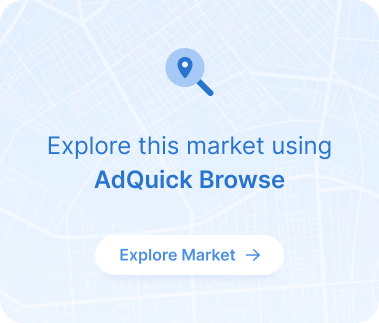Billboards in Billings
*All metrics are based on a 4-week advertising campaign
Billings, a thriving urban hub, boasts a unique blend of natural beauty and cultural attractions, making it an ideal location for outdoor advertising. With its picturesque landscapes, historic landmarks, and diverse neighborhoods, advertisers can seamlessly integrate their messages into the daily lives of residents and visitors alike. Outdoor advertising in Billings goes beyond product promotion, fostering connections between communities, brands, and individuals, creating impactful narratives that resonate with everyone who passes by.
What to look for when picking billboards
With over 210 billboards available in Billings, it's essential to consider various factors when selecting the perfect billboard for your advertising campaign. Some key aspects to keep in mind include:
- Location: Choose a billboard in a high-traffic area with good visibility, such as a busy interstate or a trendy part of town. For example, placing a billboard near a college or university can help target young adults.
- Demographics: Ensure the billboard's location aligns with the target audience's demographics. For instance, placing a billboard in an area with a high concentration of college-educated adults with above-average incomes can be beneficial.
- Size and Type: Consider the size and type of billboard that best suits your campaign. Bulletins, posters, and junior posters each have their advantages and target different audiences. Digital billboards and wallscapes can also offer dynamic messaging and unique advertising opportunities.
- Duration: Determine the optimal duration for your billboard advertisement based on your campaign goals and budget. Branding campaigns may last six to twelve months, while event promotions might only need a month of exposure.
Billboards price breakdown
In Billings, billboard pricing varies depending on factors such as location, size, and duration, with the following price data points:
- Average Price: The average price for a billboard in Billings is $1,069.02, which can provide a general idea of the cost for most campaigns.
- Median Price: With a median price of $830, this value represents the middle point in the range of billboard prices, offering a more accurate representation of typical costs.
- Lowest Price: The lowest price for a billboard in Billings is $50, showcasing the potential for affordable advertising options in the area.
Billboards Impression and CPM Metrics
Billings offers a range of impressions and CPM metrics for advertisers to consider when planning their outdoor advertising campaigns:
- Total Impressions: Billings has a total of 60,824,000 impressions, providing a substantial audience for advertisers to reach.
- Average Impressions: The average number of impressions per billboard in Billings is 311,921, showcasing the potential for consistent exposure to a wide audience.
- Median Impressions: With a median of 300,000 impressions, this value represents the middle point in the range of impressions, offering a more accurate representation of typical audience reach.
- Average CPM: The average cost per thousand impressions (CPM) in Billings is $5.80, providing a cost-effective option for advertisers to reach their target audience.
- Median CPM: With a median CPM of $3, this value represents the middle point in the range of CPMs, offering a more accurate representation of typical advertising costs per thousand impressions.
Some of the top billboard providers in Billings
Top billboard providers in Billings include:
- Adkom simplifies the process of national out-of-home media campaigns by unifying the fragmented media landscape through a single network, offering brands the opportunity to unlock untapped media opportunities and stand out from the competition.
- Lamar Advertising Company offers free design services, dedicated support, and nationwide coverage for outdoor advertising campaigns.
- Terraboost Media Operating Company LLC is a purpose-driven company that provides advertising solutions and wellness products to engage consumers and promote brand awareness.
- Mesmerize is an advertising company that offers out of home advertising solutions to reach consumers in various venues.
- YESCO is a company that specializes in producing custom signs, lighting, and other display systems for businesses, providing high-quality products and services since 1920.
Other formats for advertising in Billings
A closer look at the data reveals the depth and breadth of the other opportunities available in Billings:
- Digital Billboards: In Billings, digital billboards receive 11,200 impressions with an average CPM of $11.95. This modern and eye-catching medium allows for dynamic messaging and real-time updates, making it a popular choice for advertisers seeking flexibility and innovation.
- Retail Venues: Retail venues in Billings generate 28,000 impressions with an average CPM of $14.81. These advertising spaces are strategically placed in shopping centers and stores, capturing the attention of consumers in a buying mindset and driving sales.
- Airport: Billings Logan International Airport serves as the primary airport in the region, offering advertising opportunities to reach a diverse audience of travelers. However, specific impressions and CPM data for airport advertising in Billings is not available.
Get started with advertising with AdQuick now!
AdQuick is a powerful platform that combines technology, out-of-home (OOH) expertise, and data to connect advertisers with OOH media owners, streamlining the ad buying process and enabling efficient, measurable campaigns. With a range of products and solutions tailored for advertisers, agencies, and OOH media owners, AdQuick provides the tools and resources needed to research, plan, and execute hyper-targeted outdoor campaigns in minutes. By signing up, you'll gain immediate access to over 1,400 premium OOH media owners, execute OOH buys 10x faster, launch campaigns in as little as 48 hours, and unlock unprecedented measurability for your OOH campaigns. Don't miss out on the opportunity to revolutionize your outdoor advertising strategy – Get Started with AdQuick today!
